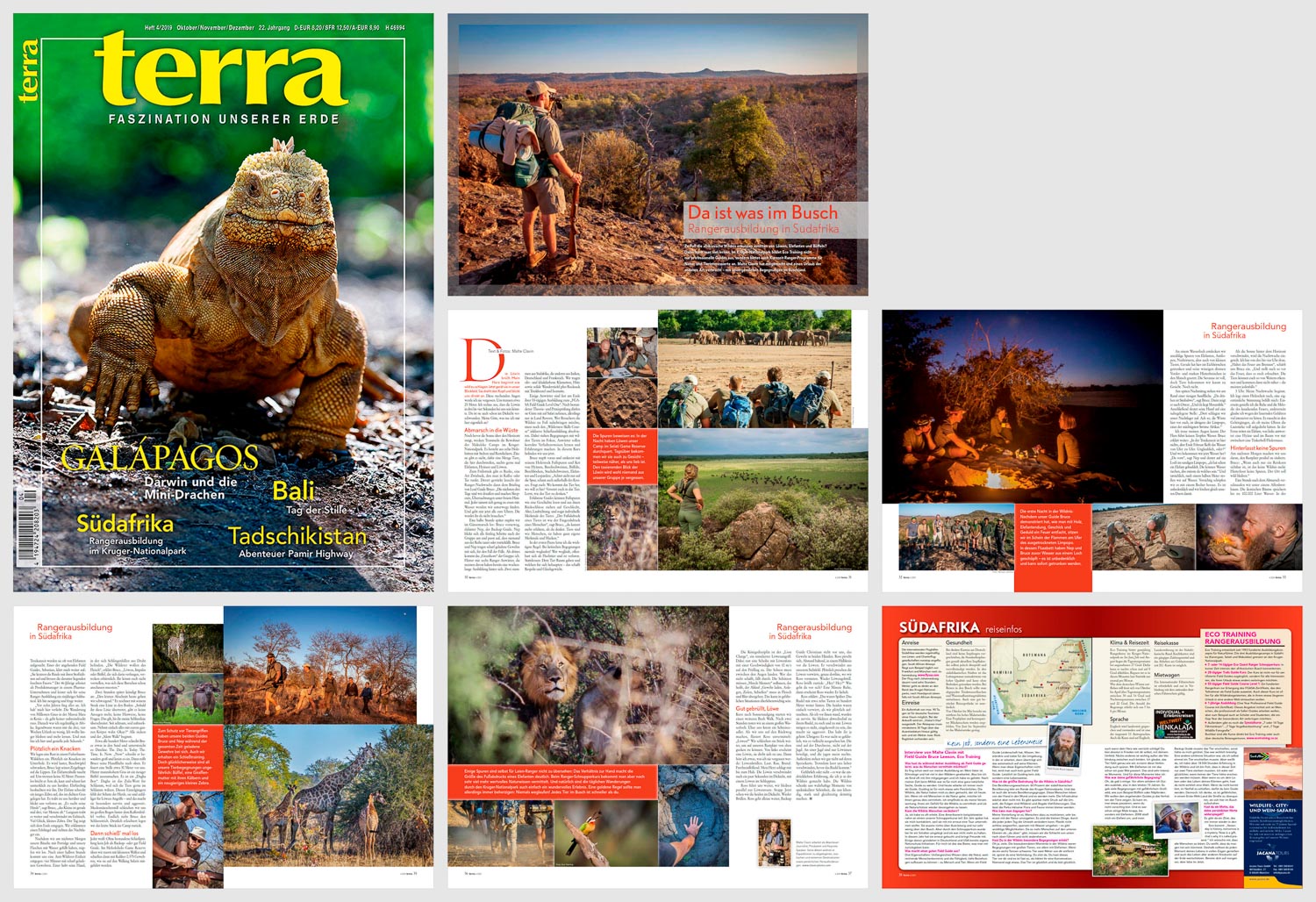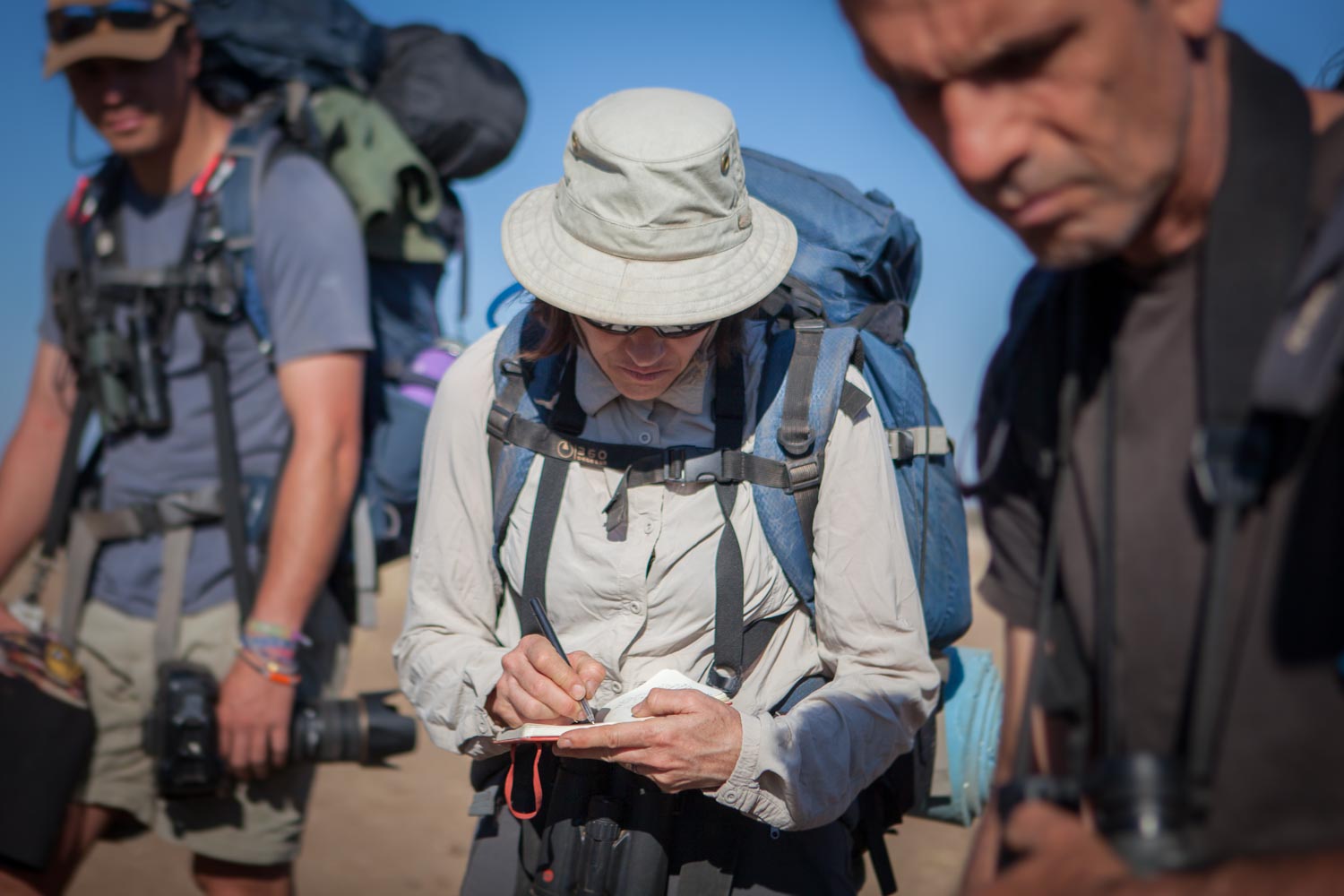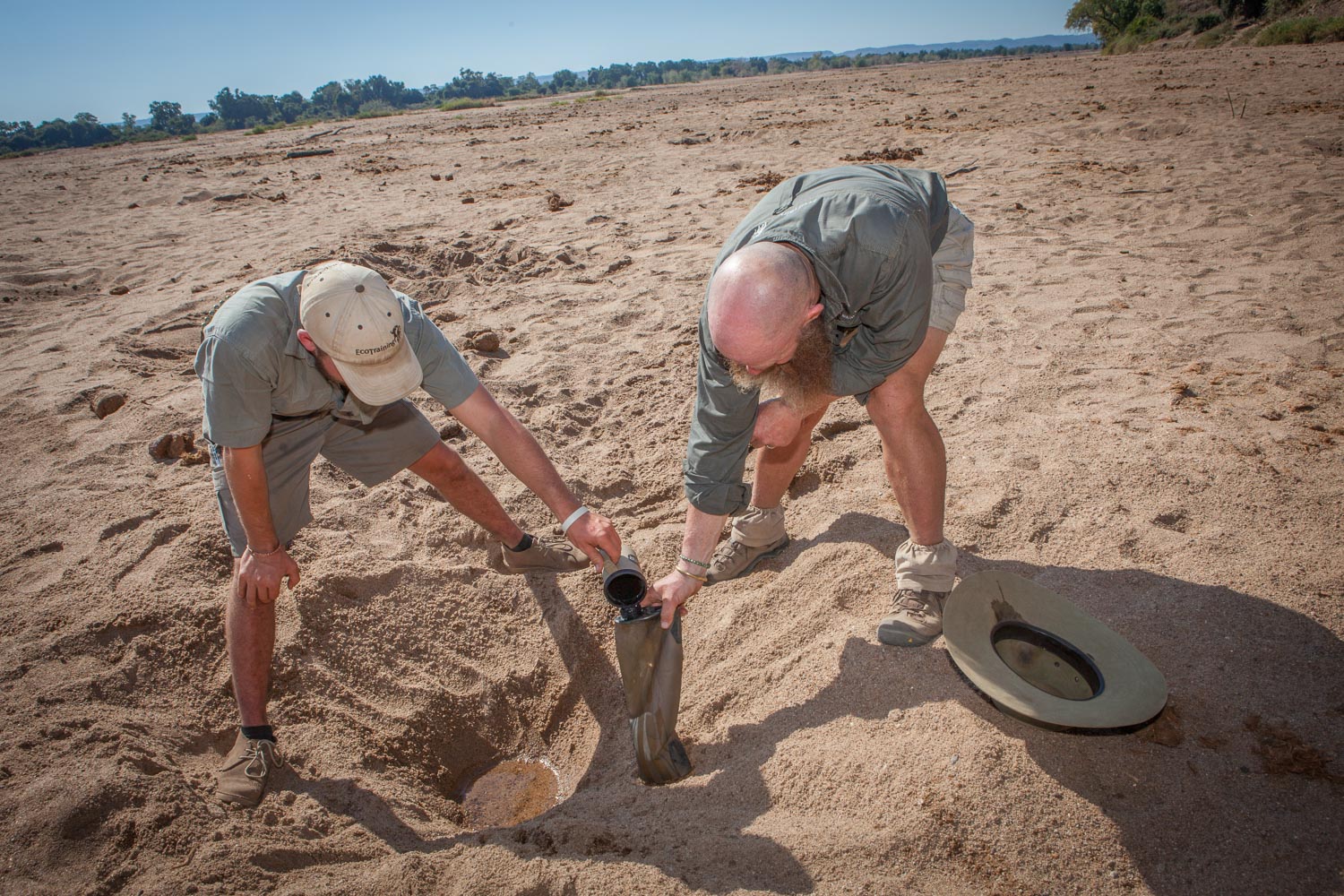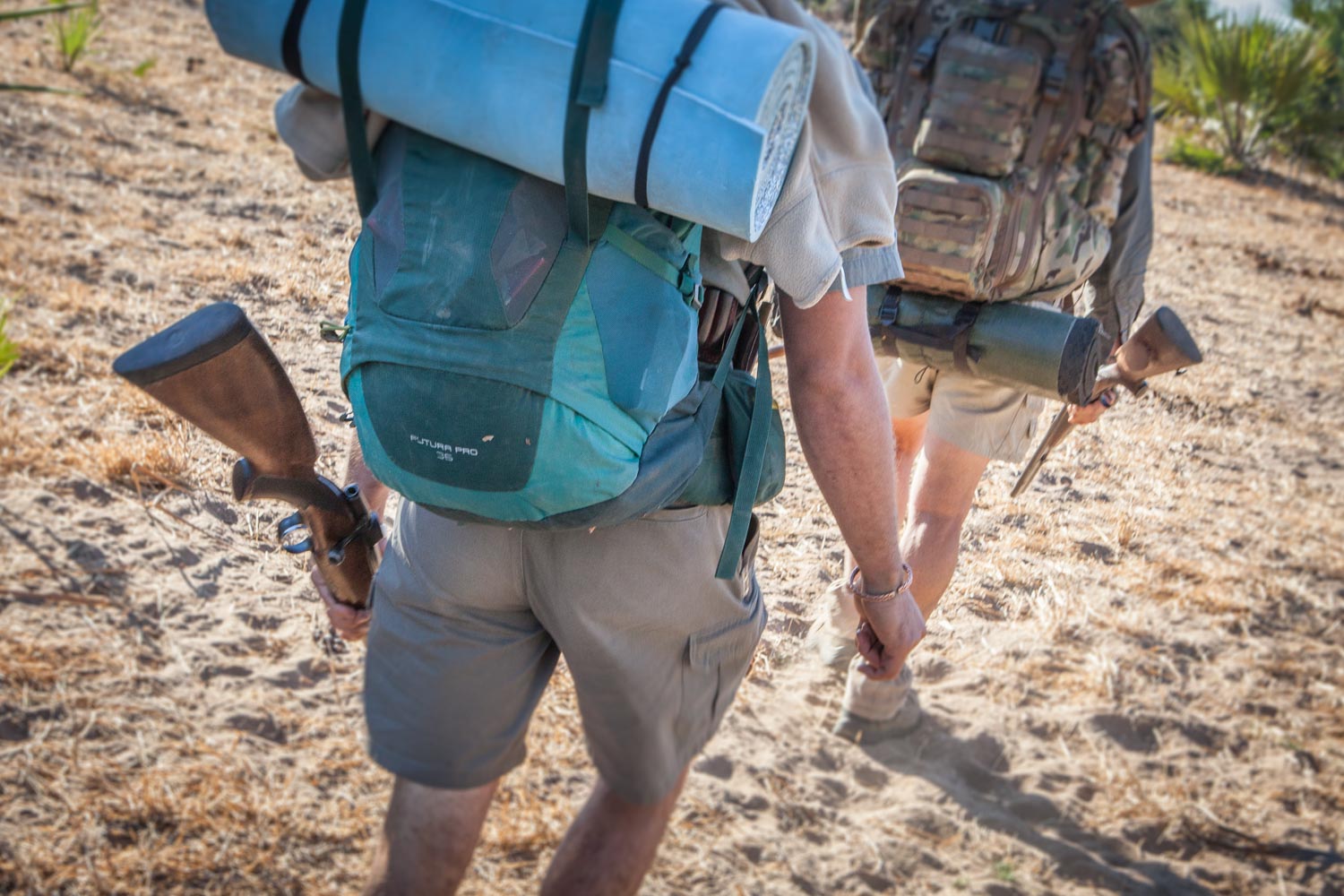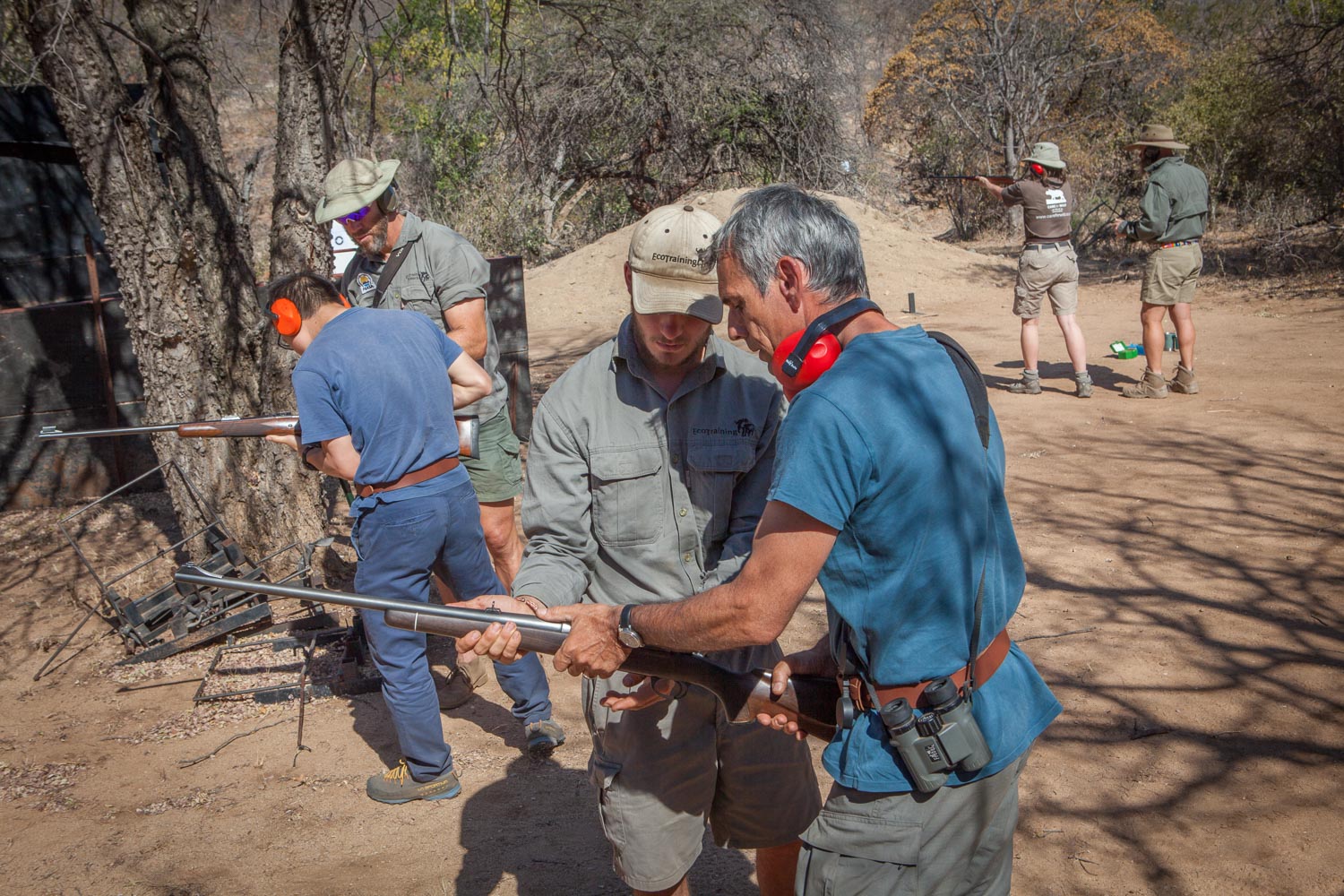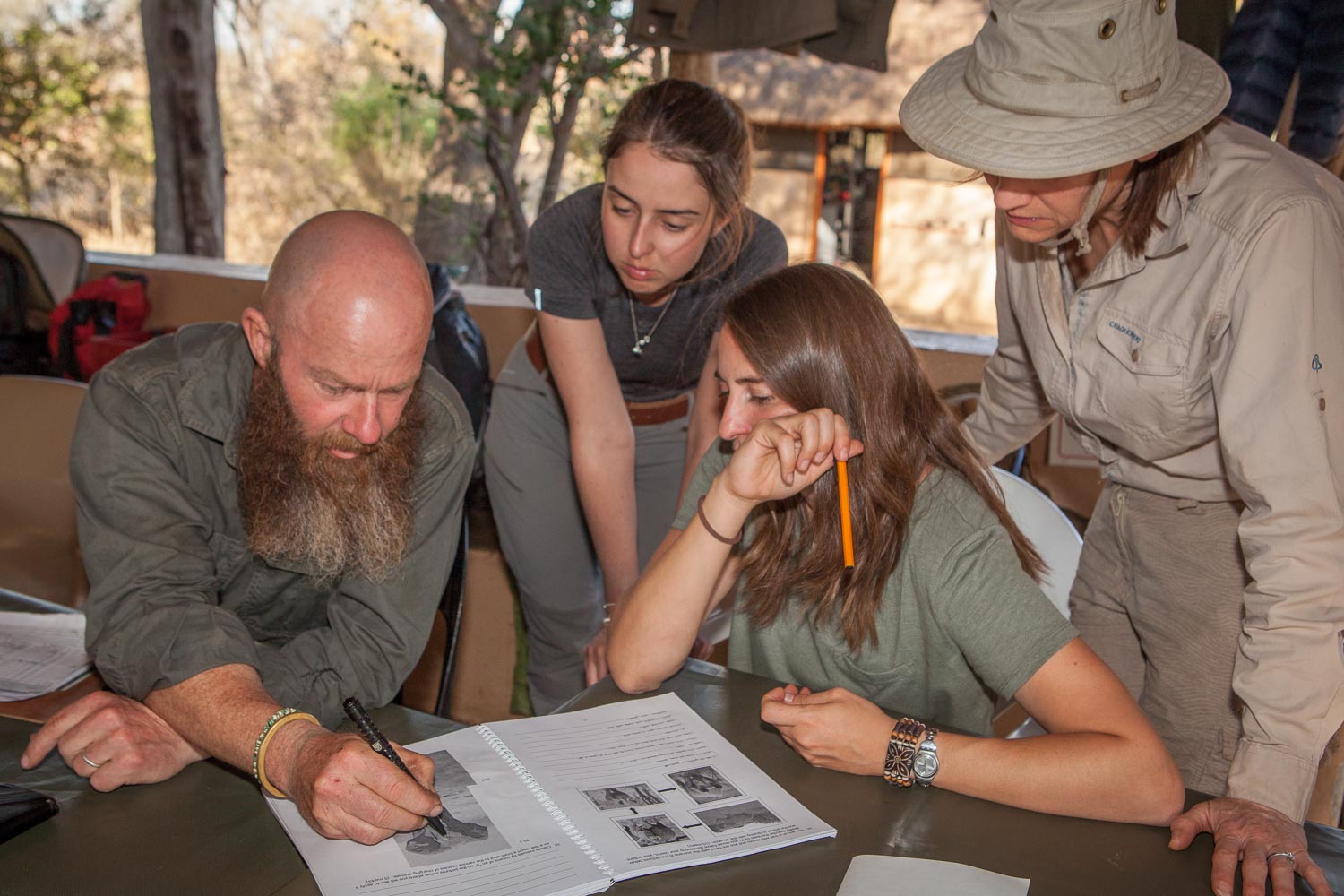Published in:

Germany’s biggest nature travel magazine
Feature | 12 pages | text & photography
The lioness roars. My heart beats like crazy. Now she appears into our range of vision. She looks around and stares directly at us. I will never forget those piercing eyes. She is 25 metres away. The lioness could probably get to us in three or four seconds. Better focus on something else. And then she has already disappeared into the bush. Goodness gracious, what have I gotten myself into?
Decamping to the wilderness
Even before the sun rises above the horizon, drums awaken the inhabitants of Makuleke Camp in the Kruger National Park. It consists of a dozen wooden huts with stilts and thatched roofs. There are no fences, but a lot of animals roam around here, at night-time mostly elephants, hyenas and lions.
Give me all your watches now. You won’t need them there.
We have rusks for breakfast, a kind of biscuit that one dips into coffee or tea. With renewed energy, the trainee rangers listen to lead guide Bruce’s briefing: “For the next three days we will be outside and do sleepouts, we camp outside. Everyone takes enough food with them. We will find water on the way. And give me all your watches now. You won’t need them there.”
Bruce is the kind of person you’d better not contradict and who doesn’t talk much anyway. Half an hour later we trudge off in single file: lead guide Bruce in front, behind him Nep, the backup guide. Nep looks back at the group every fifty paces and makes sure that no one steps out of line or falls behind.
Bruce and Nep carry loaded rifles, just in case. Third in line is the group’s ‘greenhorn’: me. Following me are six trainee rangers, most of them with weeks of training under their belts.
Two are from South Africa, the others from India, Germany and France. We wear olive and khaki clothes, hats and solid hiking boots plus a backpack with a drinking bag and sleeping mat.
Some trainees are almost at the end of their 55-day training to become “FGASA Field Guide Level One”. After passing the theoretical examination and the practical tests, they are certified to take guests on safari, but only in Land Rovers.
Those who want to introduce visitors to the wilderness on foot must complete the ‘Wilderness Skills Course’ including rifle training. The focus is on encounters with wild animals; trainees are supposed to learn correct behaviour and gain experience. This is the course we are in now.
Bruce trudges ahead and with his wooden stick draws circles around the footprints and droppings of hyenas, bush pigs, buffaloes, bushbuck, porcupines, elephants and leopards: “Don’t just see the mark, look outside the circle. Ask yourself: Where does the animal come from, where is it going? Put yourself in the animal’s place. Learn to think like the animal.”
During the Wilderness Skills Course, a lot of knowledge is imparted that cannot be found in any textbook. Kim records the newly acquired knowledge in her notebook.
Experienced guides can read footprints like a story and arrive at conclusions about the animal’s age, sex, which way it is heading and even individual characteristics. “An animal’s footprint is like a person’s fingerprint,” says Bruce, “You can find out more than you think. Animals are like people, they have their own unique characteristics and peculiarities. “
During the first break I am taught the most important rule: never run away in precarious situations! If you run away, you reveal yourself as a fleeing animal and you are finished. Give the animal space and claim some for yourself – that creates respect and a balance.
Around a waterhole we discover not only thousands of tracks of elephants, antelopes, rhinos, but also those of small animals. A squirrel has just drunk here and put its tiny thin forelegs and strong hind legs into the mud. It is crowded in the savannah, but we hardly see any animals. Not yet.
Late in the afternoon we stand at the edge of a huge expanse of sand. “Over there is Zimbabwe”, Bruce says and then points to the east “There is Mozambique”. He points to a site on the edge of the desert: “And that’s where we’ll set up camp for the night. By the way, the desert here in front of you, that’s the Limpopo, one of the mightiest rivers in Africa.”
It is crowded in the savannah, but we hardly see any animals. Not yet.
I can hardly believe my eyes: there is not a single drop of water in the river. Bruce adds: “In dry season there is nothing here, but by the end of February the river runs shore to shore. Unbelievable, isn’t it?” So where do we get water now? “Up ahead,” says Nep, pointing to a hole in the sandy Limpopo, “an elephant has already dug there.
They can smell water, so some should be there.” And sure enough, after digging down half a metre, we hit water. We carefully scoop it out with a cup. It is safe and we immediately quench our thirst with it.
At night camp we boil up our instant noodles with the water. “Bah,” Bruce growls, “Supposed to be noodles. This stuff is just two molecules away from plastic.”
The sun disappears, the moon lights up. The night watch is assigned, mine is from three to four o’clock. “Keep the fire going,” Bruce instructs us. “And be in front of the fire so that it lights you up. That way the animals can see you from a distance and won’t come any closer, most of them anyway.”
3 o’clock. My vigil begins. I put a log on the fire, a peculiar mood sets upon me: on the one hand I enjoy the peace and the melody of the crackling fire, on the other hand I think that because of the lurking dangers I hear much more intensely: there is hissing in my auditory canals as if my ears have turned up the volume to the max.
Suddenly there are grumbling and rumbling sounds. What animal is that? After moments of shock I realise: it’s my stomach. It’s busy trying to digest the instant noodles.
Far away in the distance an elephant trumpets, on the left a hyena answers and in the tree in front of me a Tinkerbell bat chirps – until its call finally falls silent.
Nep and Bruce draw water from a hole in the Limpopo River. The water is safe and can be drunk immediately.
Beating around the bush
The next morning we set about meticulously cleaning up our resting place. Bruce: “If even a grain of rice is visible, this is no longer wilderness. Don’t leave a trace. The place should remain wild.”
An hour after setting off we have a breather under a baobab tree. The iconic trees store up to 100,000 litres of water. In the dry season, they are often visited by elephants. One of the prospective field guides, Sebastian, tells me: “They scratch the bark with their tusks and eat the moist fibres underneath.”
The 46-year-old works as a product manager in a pharmaceutical company and is taking a one-year sabbatical for his ranger training. I am intrigued and pose more questions.
“It all started ten years ago. I fell in love with the place. The migration of millions of wildebeest in the Massai Mara in Kenya – no one leaves unimpressed. After that I went to Africa regularly. Once, in Zambia, elephants entered the camp and I was standing in the shower completely soaped up.
I immediately dashed out to the elephants – what a sight to behold. For the elephants too, I’m sure. At some point, three or four weeks were just too short for me. I wanted to stay longer and learn more. And now I’m here and enjoying every second. “
We take a break in a small forest of fever trees. Next to us is a mud pit that is almost as hard as concrete. Countless imprints of elephant feet and bodies are immortalised in it – and we have a good view of the surrounding area. A grey lourie makes every effort to scare us away with its ‘Go away, go away’ calls.
A bull elephant appears. Less than 30 metres away.
Suddenly there is a crackling in the scrub. It gets louder, the heads of the shrubs sway, Bruce puts his fore finger to his lips. A bull elephant appears. Less than 30 metres away. He ceaselessly tears off branches and chews, looking over at us almost imperceptibly. Awe-stricken we look on while he is busy.
The elephant startles a young zebra that has been taking a nap in the thick grass. It stomps over to us and looks at us forlornly. “It’s looking for its herd,” says Bruce, “the little one is only three or four months old. Slowly it trots on and disappears into the bush. Good luck, little zebra.
The day is drawing to a close. We climb a rocky hill and set up camp for the night.
For protection against animal attacks, Lead Guide Bruce and Backup Guide Nep carry loaded rifles at all times.
The. Time. Is. Now.
The next morning, after filling up our bellies with porridge and our bottles with water, we trudge off. After half an hour, we come upon an anti-poaching unit: four men with rifles loaded with live ammunition.
One of them raises his hand in which he carries wire snares: “The poachers want the meat,” Bruce explains, “lions, impalas or buffaloes that get caught in them die miserably. You can’t imagine what these guys have all witnessed.”
Two hours later, Bruce announces: “The last section today we go in silence.” He draws a solid line in the soil with his stick. “Once you cross this line, there will be no more announcements, no more indications, no more questions. That is until you cross my closing line. Be mindful, be alert. Just sense everything with your whole body. Okay? “Everybody nods and the silent walk begins.
About every hundred metres Bruce writes something in the sand and underscores it: Dateline. The. Day. Is. Today. The. Time. Is. Now. ‘Now’ he writes extra large and draws a circle around it. That’s when Bruce suddenly turns up the palm of his hand. He points to a spot about 30 metres ahead.
Behind head-high grass, the flanks of a huge buffalo can be made out. It is a ‘Dagha Boy’. Dagha is the Zulu word for mud, because the animals like to roll in the mud. These loners lack the protection of the herd, they are more vulnerable to lion attacks – and this makes them particularly nervous and aggressive.
Thrilled, we absorb the mighty animal’s presence with all our senses. Quiet as a mouse, we give the Cape buffalo a wide berth.
Finally Bruce draws the line. Clearly relieved, we cover the last stretch back to camp. There is little time for showering and packing. A minivan takes us to Selati Camp, about 200 km further south.
Selati is also in the middle of the wilderness and not fenced in. We sleep in spacious two-person tents, shaded by acacia trees.
Go ahead and shoot.
Everyone knows: no job as a backup guide or even field guide without passing the closing exam. In the Moholoholo Game Reserve we first practice with smaller guns and then shoot with calibre 0.375 rifles, those are carried on the walking safaris.
It culminates in the ‘Lion Charge’, a simulated lion attack. Here a target with the picture of a lion races towards the examinee at a speed of 10 m/s. The bullet must hit between the eyes. Those who do not manage, fail the exam.
Gunmen need to build up ‘muscle memory’, meaning that the cycle ‘load rifle, aim, shoot’ must become like second nature. In perilous situations this is vital for survival.
Lead Guide Bruce and Backup Guide Nep carry loaded rifles at all times for protection against animal attacks.The shooters must build up ‘muscle memory’, i.e. the cycle ‘load rifle, aim, shoot’ must become second nature. This can be crucial for survival in dangerous situations.
Hear, hear! The roar.
I wake up from the warbling of the crested francolins, chicken-like birds that forage on the ground in front of my tent. Shortly after sunrise we start another bush walk. After two hours we take a rest at a large waterhole. An African Fish Eagle circles above us.
We circumcircle the water and on a densely overgrown hillock stride back in the direction from which we came. Then Ross whispers, “Lions! “ We tiptoe a few steps on and through an open patch glance at our resting place from before. A lioness appears from the left, she turns towards us. Then I hear something I will never forget: lions roaring.
Loud. Coarse. Savage. Terrifying. I can feel my heart beat in my ears. After three seconds the lioness disappears into the thicket, with a lion in tow.
Ross leads us on, we stay parallel to the lion route. Stop. Now we see them in the thicket. Roaring again. Ross continues alone, backup Christiaan stands in front of us, holding the rifle in both hands. Keeping his distance, Ross stalks the lions in a semicircle.
He disappears from where we can see him. Suddenly the lions rush forward to exactly where we think Ross is. Again the lions roar. Ross roars back, “Hey! Hey!” What is going on? Silence for a minute, then Ross reappears. He smiles.
Lions roaring. Loud. Coarse. Savage. Terrifying.
Ross explains: “They were scouts. The pride of about ten animals is a hundred metres further back. They were just confused when we suddenly appeared. When I stood in front of them, they got nervous. They were looking in turn in the direction of their pride, at you and at me. Lions don’t like being encircled, it makes them aggressive. You heard that.
By the way, it wasn’t as dangerous as it might have seemed. They were passing through, not hunting. Only lionesses hunt, and they usually hunt at night. Besides, we’re not even on their menu. But for now, let’s get out of here before the pride arrives.”
Bruce uses photos to explain to Sophie, Martina and Kim where the brain is located in different animals. In case of an attack, the shooter has to hit it with his first shot.
Dangerous or not – that wilderness experience was the one that left the biggest imprint on me.
“The bush teaches me to always be fully present and concentrated and to use all my senses. Here I am constantly smelling, hearing, looking, touching. And I teach myself to relax and let go. We are in the bush and have no more water? Well, we’ll just dig until we find some. “I have much less here than at home, and yet I feel more whole.” That’s how Sebastian describes it.
The wilderness presents you with moments of truth. It is scenes of spectacular beauty that make you feel alive, wild and humble. That leads to an inner space of great peace and serenity. Whoever has been eye to eye with a wild animal, becomes one. For he who is vulnerable can also be amazed and impressed more easily. And to be amazed and impressed is what life is all about.
Read more:
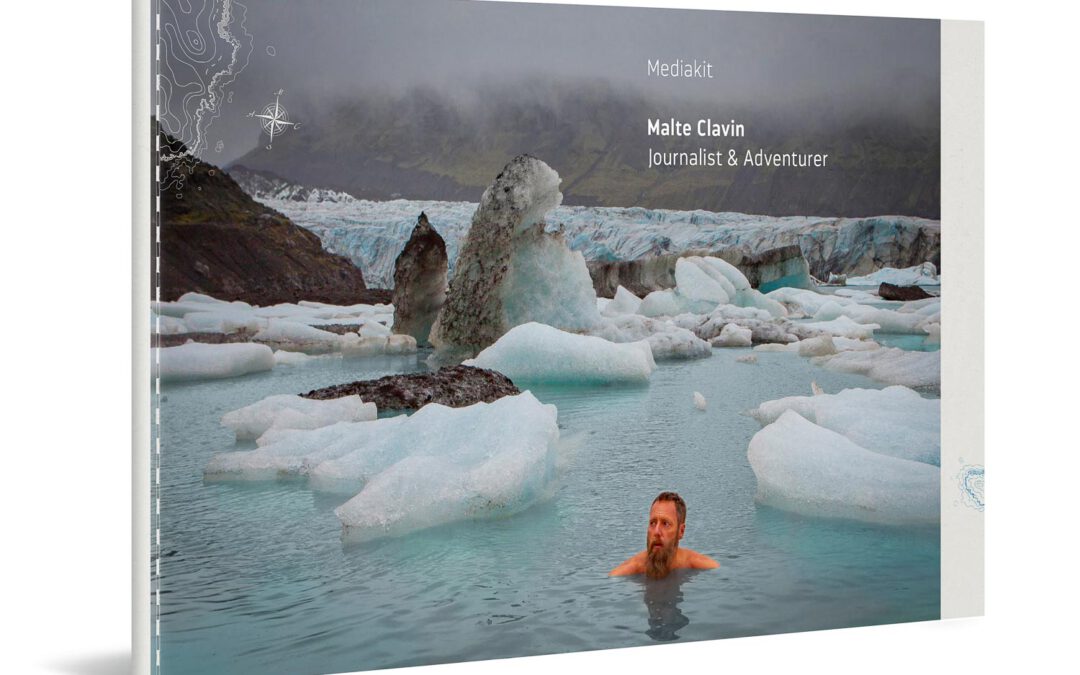
Pure inspiration
My new media kit 2025
< 1 Min.In this brand new 28-page media kit, I show you my work as an adventure journalist and speaker: Expeditions, travels, challenges – everything that excites me. Let yourself be inspired.
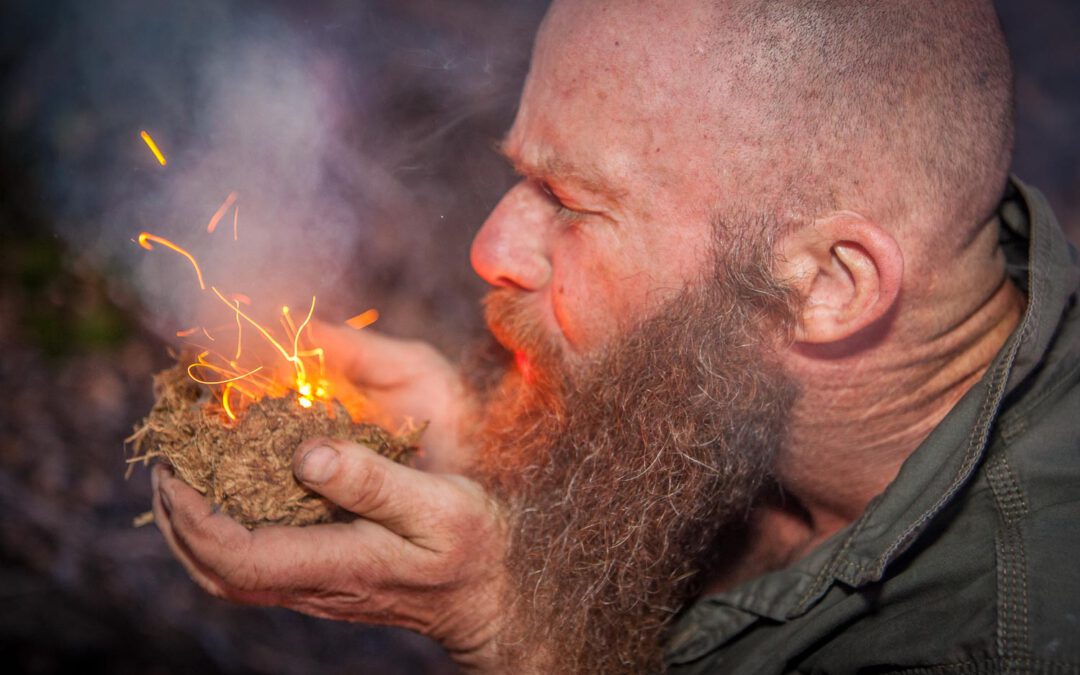
Interview with South African ranger legend
“Wilderness and nature have made me who I am today.”
8 Min.Bruce Lawson has worked as a field guide / wilderness warden since 1992 and has over 18,500 hours of logged wilderness experience. He is one of the most impressive people I have met in my life. Here is my interview with him.
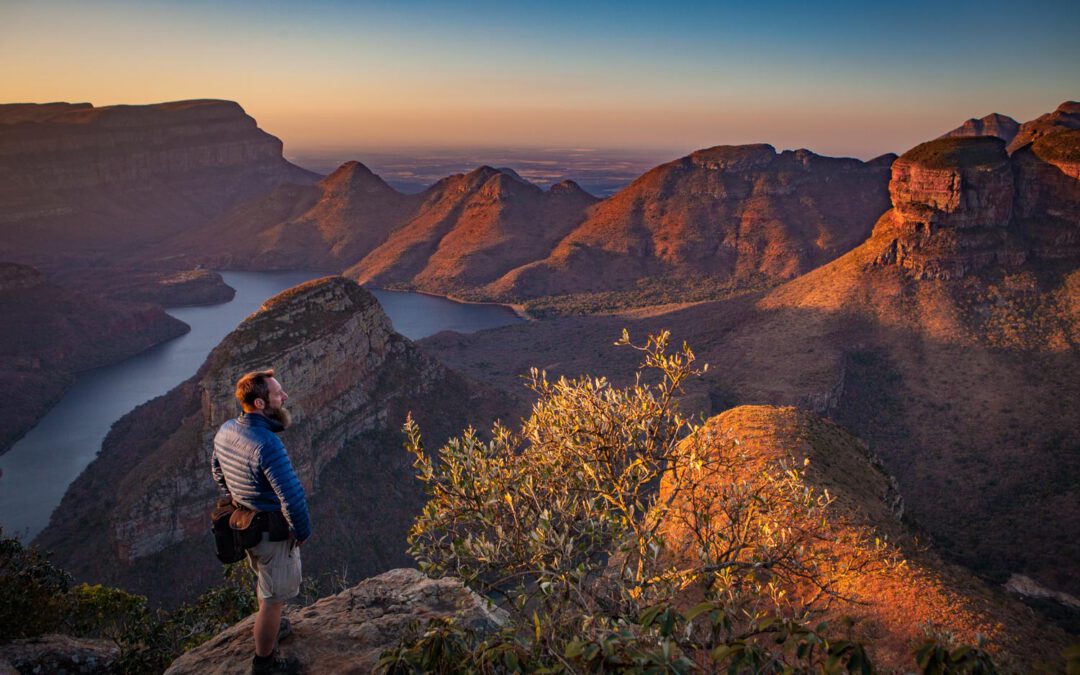
Ranger training on the edge of the Kruger National Park
South Africa photo gallery
< 1 Min.Exploring the wilderness on foot in the midst of lions, elephants and buffalo? You can learn to do that. In summer 2019, I will join a field guide course in South Africa.

